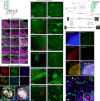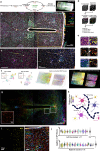INSIHGT: an accessible multi-scale, multi-modal 3D spatial biology platform
- PMID: 39738072
- PMCID: PMC11685604
- DOI: 10.1038/s41467-024-55248-0
INSIHGT: an accessible multi-scale, multi-modal 3D spatial biology platform
Abstract
Biological systems are complex, encompassing intertwined spatial, molecular and functional features. However, methodological constraints limit the completeness of information that can be extracted. Here, we report the development of INSIHGT, a non-destructive, accessible three-dimensional (3D) spatial biology method utilizing superchaotropes and host-guest chemistry to achieve homogeneous, deep penetration of macromolecular probes up to centimeter scales, providing reliable semi-quantitative signals throughout the tissue volume. Diverse antigens, mRNAs, neurotransmitters, and post-translational modifications are well-preserved and simultaneously visualized. INSIHGT also allows multi-round, highly multiplexed 3D molecular probing and is compatible with downstream traditional histology and nucleic acid sequencing. With INSIHGT, we map undescribed podocyte-to-parietal epithelial cell microfilaments in mouse glomeruli and neurofilament-intensive inclusion bodies in the human cerebellum, and identify NPY-proximal cell types defined by spatial morpho-proteomics in mouse hypothalamus. We anticipate that INSIHGT can form the foundations for 3D spatial multi-omics technology development and holistic systems biology studies.
© 2024. The Author(s).
Conflict of interest statement
Competing interests: C.U.H.K. filed a patent application in part based on the invention described in this paper with H.M.L. and C.N.Y. as the inventors. The associated patent, owned by C.U.H.K., was exclusively licensed to Illumos Limited, of which H.M.L. is a co-founder. The remaining authors declare no competing interests.
Figures








Similar articles
-
Consensus draft of the native mouse podocyte-ome.Am J Physiol Renal Physiol. 2022 Aug 1;323(2):F182-F197. doi: 10.1152/ajprenal.00058.2022. Epub 2022 Jul 7. Am J Physiol Renal Physiol. 2022. PMID: 35796460
-
A versatile pipeline for the multi-scale digital reconstruction and quantitative analysis of 3D tissue architecture.Elife. 2015 Dec 27;4:e11214. doi: 10.7554/eLife.11214. Elife. 2015. PMID: 26673893 Free PMC article.
-
Framework for 3D histologic reconstruction and fusion with in vivo MRI: Preliminary results of characterizing pulmonary inflammation in a mouse model.Med Phys. 2015 Aug;42(8):4822-32. doi: 10.1118/1.4923161. Med Phys. 2015. PMID: 26233209 Free PMC article.
-
A review on deep learning applications in highly multiplexed tissue imaging data analysis.Front Bioinform. 2023 Jul 26;3:1159381. doi: 10.3389/fbinf.2023.1159381. eCollection 2023. Front Bioinform. 2023. PMID: 37564726 Free PMC article. Review.
-
Bridging scales: From cell biology to physiology using in situ single-cell technologies.Cell Syst. 2021 May 19;12(5):388-400. doi: 10.1016/j.cels.2021.03.002. Cell Syst. 2021. PMID: 34015260 Review.
Cited by
-
Intracranial Recordings in Epilepsy: an Approach to Understanding the Neural Mechanisms of Social Cognition.Curr Neurol Neurosci Rep. 2025 Jun 28;25(1):44. doi: 10.1007/s11910-025-01431-9. Curr Neurol Neurosci Rep. 2025. PMID: 40580385 Free PMC article. Review.
-
Use of bovine serum albumin might impair immunofluorescence signal in thick tissue samples.Sci Rep. 2025 Jul 1;15(1):21920. doi: 10.1038/s41598-025-06876-z. Sci Rep. 2025. PMID: 40594992 Free PMC article.
References
-
- Moses, L. & Pachter, L. Museum of spatial transcriptomics. Nat. Methods19, 534–546 (2022). - PubMed
-
- Liu, J. T. C., Glaser, A. K., Poudel, C. & Vaughan, J. C. Nondestructive 3D pathology with light-sheet fluorescence microscopy for translational research and clinical assays. Annu. Rev. Anal. Chem.16, 231–252 (2023). - PubMed
Publication types
MeSH terms
LinkOut - more resources
Full Text Sources
Miscellaneous

